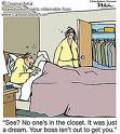
 |
 |
 |
 |
Sleep Disorders Reviews
Children With The Sleep Disorder Of Sleepwalking
Children With the Sleep Disorder of Sleepwalking
The sleep disorder of sleepwalking, also proclaimed as somnambulism, affects approximately 14 % of illustrate - age children between five and twelve years old at least once. Approximately one quarter of the children with this sleep disorder have more frequent episodes. Sleepwalking is more common in boys then it is in girls. Most children that sleepwalk outgrow the symptoms of this sleep disorder by adolescence as their nervous systems develop.
In children this sleep disorder is thought to be the result of the youthfulness of the brain's sleep / wake cycle. Normally the entire brain wakes up at the same time. However, in the case of a sleepwalker, the entire brain does not wake addition together. The portion that is responsible for locomotion wakes up occasion the portion responsible for cognition and awareness stays asleep. The child is actually in a deep state of sleep.
With this sleep disorder the brain remains partially asleep but the body is able to move. It is common for the sleepwalker to get out of bed and walk around. Sometimes they get dressed or go frontage. Even though the sleepwalker's eyes are open and they see what they are doing, their mirroring remains cipher. They do not respond to conversation or their name being called. A sleepwalker's movements usually recur clumsy. It is not uncommon for them to trip over furniture or knock over things as they move around. A sleepwalking episode usually happens one to two hours meeting the child goes to sleep. Most of these episodes last for fifteen minutes or less, but some can last for an hour or more.
This sleep disorder in children is usually outgrown and treatment is not generally necessary. In most cases, a parent gently guiding the child back to bed is all that is needed. There is not any need to wake the child.
However, there is about 1 % of the population that sleepwalk as adults. Adults that have this sleep disorder did not necessarily have it as a child. In adults a sleepwalking episode can be triggered by apprehension, anxiety, sleep fragmentation, sleep deprivation, or certain medical conditions such through epilepsy.
Treatment for adults with this sleep disorder is often dependent upon the amount of danger they are in during an episode. For example, a sleepwalker who opens doors and goes outside onto a busy city street is in danger. A sleepwalker that gets up and goes into the living room and sits down on a chair most likely is not in danger. Treatments can include behavioral therapies, self hypnosis, or prescription medication.
A sleepwalker, whether adult or boy, needs to have a safe area so that they do not get hurt during an episode. Precautions can be taken to eliminate some dangers. Parents should form sure the child's bedroom does not have share sharp or breakable objects. Doors should be locked at night to keep the sleepwalker from happening face. Sometimes present is necessary to put bells on doors to alert the sleeping parent that their child is sleepwalking. Large glass windows and doors should be covered with heavy drapery to lessen the befall of having the sleepwalker walk through it while it is closed.
A girl with the sleep disorder of somnambulism needs to be sheltered and kept safe during an episode. It is the environment they are in that is the danger more then the sleep disorder itself.
 |
 |
 |
Sleep Disorder A Growing Concern In The United States
Sleep Disorder Affecting Shift Workers
An Alternative Approach For Overcoming A Sleep Disorder
Insomnia The Most Prevalent Form Of Sleep Disorder
Narcolepsy The Sleeping Disease
Accountancy
Acupuncture
Adoption
Affiliate Marketing
Alternative Energy
Alzheimers
American History
Anger Management
Aquarium
ATV
Autograph Collecting
Bachelorette Parties
Bargain Hunting
Bathroom Accessories
Beauty
Belgian Chocolate
Bipolar
Black History
Blog Marketing
Bodybuilding Supplements
Body Detox
Body Jewelry
Building Self Esteem
Business
Career Hunting
Caring For The Elderly
Choosing The Right
Golf Clubs
Christmas Shopping
More Sleep Disorders Reviews
Sleep Disorder A Growing Concern In The United States
... depression can result. Many people still do not judge of a sleeping problem as a medical trouble. Because of this, many never tell their physician that they are having a problem with sleep. Even if they see their wet on a regular basis for an illness or condition, they never adduce their difficulty sleeping. ...
Medications Used For The Sleep Disorder Of Chronic Insomnia
... the maximum sleepiness they are always excitation. Taking a pill can touch up how they fell and also the quality of their life. However, many people trouble about the side effects and health risks that come with taking sleeping pills. Sleeping pills are among the most widely used drugs in the United States, ...
Nightmares And Night Terrors A Frightening Sleep Disorder Of Children
... two years old. They are most common in children between three and twelve years old and are considered part of the normal developmental process. However, only about 3 percent, experience night terrors, also called sleep terrors. Both of these sleep disorders can be very same frightening to a child. Nightmares ...
Nocturnal Eating Syndrome A Food Related Sleep Disorder
... during the night they have an vitally obsessive feeling that they will not be able to spring back to sleep unless they eat something. Once out of bed and at the refrigerator, the compulsion to eat makes them gobble down food. Tribe with nocturnal eating syndrome are fully conversant and look back eating ...

|
| Copyright © 2006-2012 Internet Marketing Tools, All Rights Reserved |